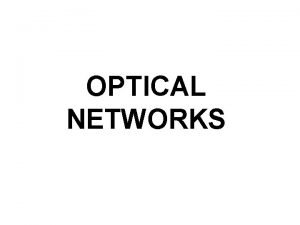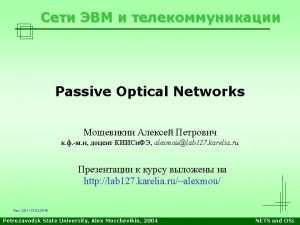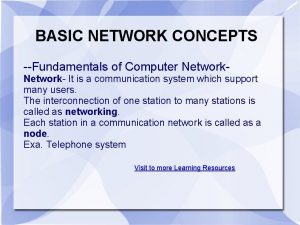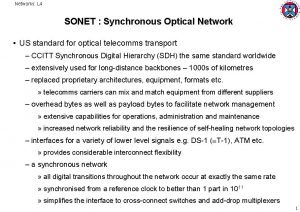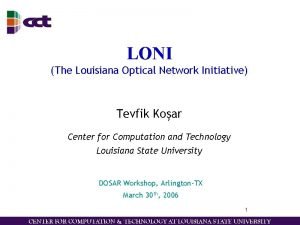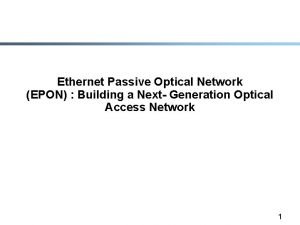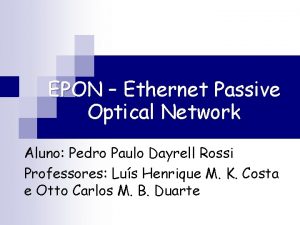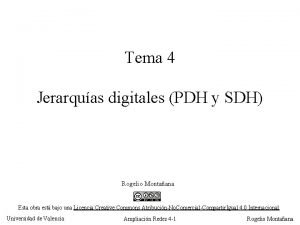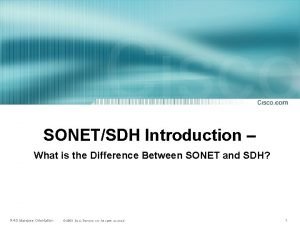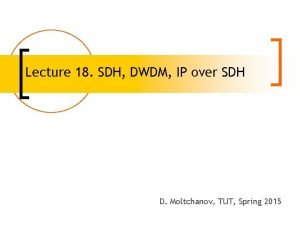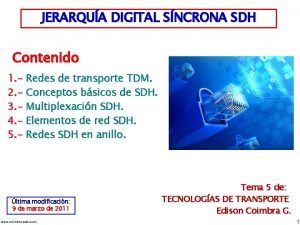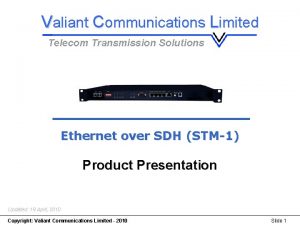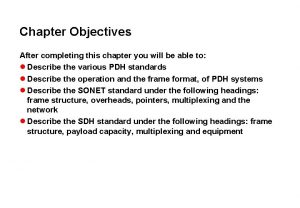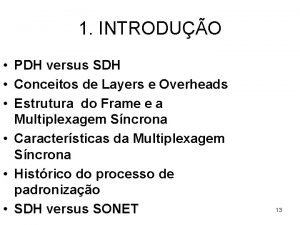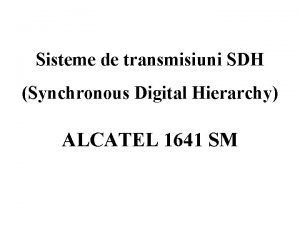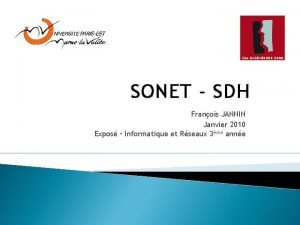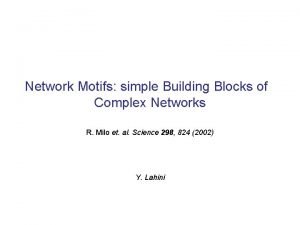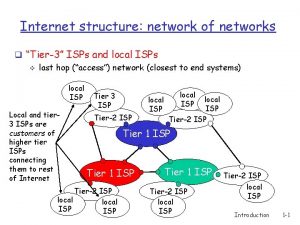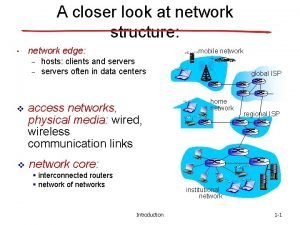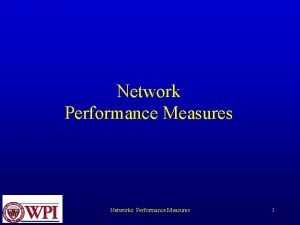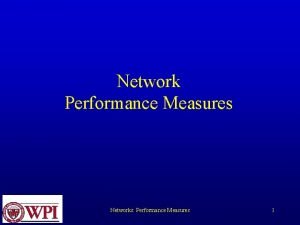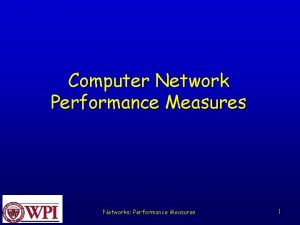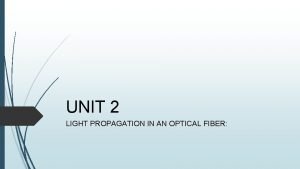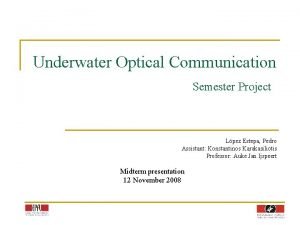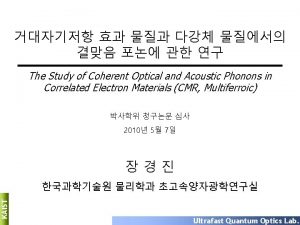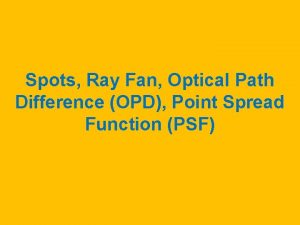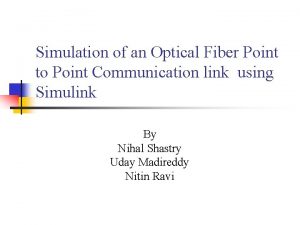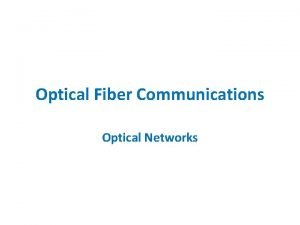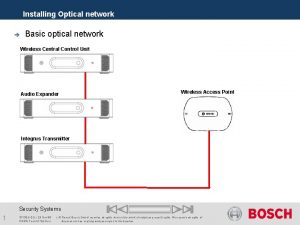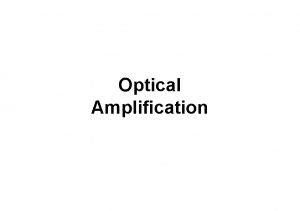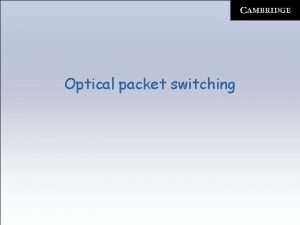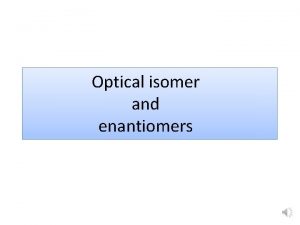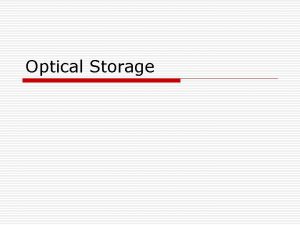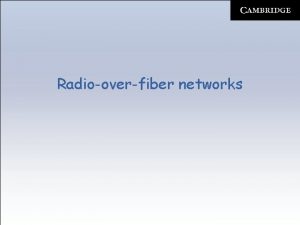OPTICAL NETWORKS Topics 1 Network Concepts 2 SDH































































- Slides: 63

OPTICAL NETWORKS

Topics 1. Network Concepts 2. SDH/ SONET* 3. High Speed Lightwave links

Network Concepts 1. Network Terminology 2. Network Categories 3. Network Layers 4. Optical Layer

Network Terminology Stations: Collections of devices that users employ to communicate are called stations. These may be computers, terminals, telephones, or other equipment for communicating. Stations are also referred to as data terminal equipment (DTE) in the networking world. Networks: To establish connections between these stations, one deploys transmission paths running between them to form a collection of interconnected stations called a network. Node: Within this network, a node is a point where one or more communication lines terminate or where stations are connected. Trunk: The term trunk normally refers to a transmission line that runs between nodes or networks and that supports large traffic loads.

Topology: The topology is the logical manner in which nodes are linked together by information transmission channels to form a network. Switching and routing: The transfer of information from source to destination through a series of intermediate nodes is called switching, and the selection of a suitable path through a network is referred to as routing. Router: When two networks that use different information-exchange rules (protocols) are interconnected, a device called a router is used at the interconnection point to translate the control information from one protocol to another.

Network Terminology Definitions of various elements of a network.

Network Categories Local Area networks: (LANs) interconnect users in a localized area such as a room, a department, a building, an office or factory complex, or a campus. LANs usually are owned, used, and operated privately by a single organization. Access network: It lies between a metro and a LAN. It encompasses connections that extend from the CO to individual businesses, organizations, and homes. A particular access network is owned by a single teleco service provider. Metropolitan Area network: Connects groups of central offices within a city or a city-size geographic region. MANs are owned and operated by many organizations.

Wide Area networks : Span a large geographic area. The links between switching facilities in neighboring cities to long-haul terrestrial transmission lines. WANs are owned and operated by either private enterprises or telecommunication service providers. Undersea networks: Use undersea cables to connect continents. These cables could be several thousand kilometers in length, such as those running across the Atlantic Ocean between North America and Europe or SEA-ME-WE-3 , and SEA-ME-WE-4


Enterprise and Public Networks Enterprise Network: A private organization (for example, a company, a government entity, a medical facility, a university ) owns and operates a network. Public Network: Networks that are owned by the telecommunications carriers provide services such as leased lines or real time telephone connections to the genera public. Central office: A communication switching facility in a public network is calleda central office (CO) or a point of presence (POP).

Backbone network: The term backbone describes a high-capacity network that connects multiple LAN, MAN, or WAN segments. Thus, a backbone handles internetwork traffic. Long-haul network: A long-haul network interconnects various cities or geographical regions and spans hundreds to thousands of kilometers between central offices. Passive Optical Network: Optical distribution networks that do not require any active optoelectronic components in the access region offer a number of operating advantages over the other media. This implementation is called passive optical networks (PON) and is the basis for the fiber to the premises networks.

Links > 50 Km Links < 50 Km (e. g, a PON) Links < 1 Km Links ≤ 20 Km Definitions of some terms used in describing different segments of a public network.

Architecture of a typical passive optical network.

Networks Layers Physical Layer: Refers to a physical transmission medium, such as a wire or an optical fiber, that can handle a certain amount of bandwidth. responsible for actual transmission of bits across a fiber or wire. Data link layer: It establishes, maintain, and release links that directly connect two nodes. Its functions include framing , multiplexing, and demultiplexing of data. Dominant protocols are point-to-point protocol (PPP) and the highlevel data link control (HDLC) protocol. Network layer: Its function is to deliver packets from source to destination across multiple network links. Currently the dominant network layer protocol is the Internet Protocol (IP). Transport layer: is responsible for reliably delivering the complete message from the source to the destination to satisfy a quality of service (Qo. S) requested by the upper layer. Dominant protocols TCP and UDP

General structure and functions of the seven-layer OSI reference model.

Optical Layer The physical layer provides a physical connection between two nodes, the optical layer provides lightpath services over that link. A lightpath is an end-to-end optical connection that may go through one or more intermediate nodes. For example, in an eight-channel WDM link there are eight lightpaths, which may go over a single physical line. Optical layer processes: wavelength multiplexing, adding and dropping of wavelengths, and support of optical cross-connects or wavelength switching. Networks which have these optical layer functions are referred to as wavelength-routed networks.

The optical layer is a wavelength-based concept and lies just above the physical layer.

The optical layer carries out processes such as multiplexing, adding/dropping of wavelengths, and support of optical cross-connects or wavelength switching.

Intentionally Left Blank

SDH / SONET 1. Introduction to SDH/ SONET • Applications / advantages/ disadvantages 2. Physical Configuration 3. SONET/ SDH Layers 4. Transmission Formats and Speed 5. Optical Interfaces Specifications 6. SONET/ SDH Rings 7. SONET/SDH Networks

Introduction to SDH / SONET ITU-T standards is called the Synchronous Digital Hierarchy (SDH) ANSI standards is called the Synchronous Optical Network (SONET) Three Important concerns in designing SONET/ SDH* 1. It is a Synchronous network. • A single clock is used to handle the timing of transmission and equipment across the entire network. • Network wise synchronization adds a level of predictability to the system. • This predictability , coupled with powerful frame design, enables individual channels to be multiplexed, thereby improving speed and reducing cost. 2. Standardization. • SDH/SONET contains recommendations for the standardization of fiber optic transmission system equipment sold by different manufacturers.

Introduction to SDH / SONET 3. Universal Connectivity. • SDH/SONET physical specification and frame design include mechanism that allow it to carry signals from incompatible tributary systems. This flexibility gives SONET/ SDH a reputation for universal connectivity. Applications: 1. Carrier for ISDN and B-ISDN. 2. Carrier for ATM cells. 3. Can support bandwidth on demand. 4. Can be used as the backbone or totally replace other networking protocols such as SMDS or FDDI. 5. Can replace PDH system, E 1, E 3 lines.

Introduction to SDH / SONET Advantages of SDH Flexible New generation of multiplexers with direct access to every single low-speed tributary (e. g. 2 Mbit/s/1. 5 Mbit/s), sophisticated signal protection mechanisms Cost effective Integration of multiplex, cross-connect and line terminal functions as part of a softwarecontrolled network element Manageable Adequate and standardized signal overhead capacity for remote operation, administration and maintenance (OAM) Standardized line signal as a uniform interface for all manufacturers (multi-vendor policy) International Uniform multiplexing principle for both existing hierarchies (USA and Europe)

Disdvantages of SDH Abundant Overheads bits low bandwidth utilization ratio, contradiction between efficiency and reliability Pointer adjustment Mechanism of pointer adjustment is complex, it can cause pointer adjustment jitters Software based Large-scale application of software makes SDH system vulnerable to viruses or mistakes.

Physical Configuration* Add/drop multiplexer Regenerator MUX Section Line Path

Multiplexer/ Demultiplexer: Multiplexer marks the beginning and end points of a SDH link. They provide interface between a tributary network and SDH and either multiplex signals from multiple sources into an STM signal or demultiplex as STM signal into different destination Signals. Regenerator: Regenerator extend the length of the links, it takes optical signal and regenerates. SDH regenerator replaces some of the existing overhead information with new information. These devices function at the data link layer. Add/ drop multiplexer: It can add signals coming from different sources into a given path or remove a desired signal from a path and redirect it without demultiplexing the entire signal. Instead of relying on timing and bit position add/drop multiplexer use header information such as addresses and pointers to identify the individual steams.

Section: It is the optical link connecting two neighbor devices: • Multiplexer to Multiplexer • Multiplexer to Regenerator • Regenerator to Regenerator Line: It is the portion of the network between two multiplexers: • STM Multiplexer to add/drop multiplexer • Two add/drop multiplexers • Two STM multiplexers Paths: It is the end to end portion of the network between two STM multiplexers. In a simple SDH of two multiplexers linked directly to each other, the section, line, and path are the same.

SONET/SDH Layers Path layer Line layer Data link Section layer Photonic layer Physical

SONET/SDH Layers Photonic Layer: Corresponds to the physical layer of the OSI model. It includes physical specifications for the optical fiber channel, the sensitivity of the receiver, multiplexing functions, and so on. It uses NRZ encoding. Section Layer: It is responsible for the movement of a signal across a physical section. It handles framing, scrambling and error control. Section layer overhead is added to the frame at this layer. Line Layer: It is responsible for the movement of a signal across a physical line. Line overhead (Pointers, protection bytes, parity bytes etc) is added to the frame at this layers. STM multiplexer and add/drop multiplexers provide line layer functions. Path Layer: It is responsible for the movement of a signal from its optical source to its optical destination. At the optical source, the signal is changed from an electronic form into an optical form, multiplexed with other signals, and encapsulated in a frame. Path layer overhead is added at this layer. STM multiplexer provide path layer functions.

Device Layer Relationship Path Line Section Section Photonic Photonic Regenerator MUX Add/drop multiplexer

Transmission Formats and speeds Commonly Used SONET and SDH Transmission Rates QUIZ: No of E 1 s in STM-1, STM-4, STM-16 and STM-64 ?

Transmission Formats and speeds Line rate calculation 9 270 Total Frame Capacity: 270 X 9 = 2430 Bytes Total Number of Bits = 2430 X 8 = 19440 Bits Time Period of One Frame = 125 microseconds Bits/Second = 19440/125 X 10 -6 = 155. 52 Mbits/Sec = STM-1 4 X STM-1 = STM-4 4 XSTM-4 = STM-16

Transmission Formats and seeds SDH components v SDH Frame is made of the following – SDH payload – Pointer – Path Over head – Section Overhead » Multiplex section overhead » Regenerator section overhead Overhead is fixed and is like a Header. It contains all information including Monitoring, O&M functions etc.

Transmission Formats and speeds SDH Frame 2 34 140 270 x N Columns MSOH 1 Byte POH 9 Rows RSOH Pointer 261 Bytes Payload Actual Traffic STM-1, STM-4, STM-16, STM-64, STM-256 SDH

Optical Interfaces Specification SONET and SDH specifications provide details of: 1. Optical source characteristics 2. Receiver sensitivity, 3. Transmission distances for various types of fibers. Transmission Distances and Their SONET and SDH Designations, Where x Denotes the STM-x Level

The optical fibers specified in ITU-T G. 957 fall into the following three categories and operational windows: 1. Graded-index multimode in the 1310 -nm window. 2. Conventional nondispersion-shifted single-mode in the 1310 - and 1550 -nm windows 3. Dispersion-shifted single-mode in the 1550 -nm window Table shows the wavelength and attenuation ranges specified in these fibers for transmission distances up to 80 km. Wavelength Ranges and Attenuation for Transmission Distances up to 80 km

Source Output, Attenuation, and Receiver Ranges for Various Rates and Distances up to 80 km (ITU-T G. 957)

SONET/ SDH Rings • SONET and SDH are configured as either ring or mesh architecture. • So Loop diversity is achieved in case of link or equipment failure. • SONET/SDH rings are commonly called self-healing rings. Means automatic switching to standby link on failure or degradation of the link. Three main features of SONET/SDH rings: 1. There can be either two or four fibers running between the nodes on a ring. 2. Operating signals can travel either clockwise only (unidirectional ring) or in both directions around the ring (which is called bidirectional ring). 3. Protection switching can be performed either via line-switching or a path switching scheme. • Line switching moves all signal channels of an entire STM-N channel to a protection fiber. • Path switching can move individual payload channels within a STM-N channel to another path.

SONET/ SDH Rings Following two architectures have become popular for SONET and SDH Networks: 1. Two fibers, unidirectional, path-switched ring (twofiber UPSR) 2. Two fiber or four fiber, bidirectional, line switched ring( two fiber or four fiber BLSR) 3. (They are also referred to as unidirectional or 4. bidirectional self healing ring , USHRs or BSHRs)

SONET/ SDH Rings Generic two fiber unidirectional path-switched ring (UPSR) with counter rotating protection path. Flow of primary and protection traffic from node 1 to node 3

SONET/ SDH Rings Architecture of a four-fiber bidirectional line-switched ring (BLSR).

SONET/ SDH Rings Reconfiguration of a four-fiber BLSR under transceiver or line failure.

SONET /SDH Networks SONET/SDH equipment allows the configuration of a variety of network architectures, as shown in next slide. For example • Point-to-point links • Linear chains • UPSRs • BLSRs • Interconnected rings Each of the individual rings has its own failure recovery mechanisms and SONET/SDH network management procedures. An important SONET/SDH network element is the add/drop multiplexer (ADM). This piece of equipment is a fully synchronous, byte-oriented multiplexer that is used to add and drop subchannels within an OC-N signal. The SONET/SDH architectures also can be implemented with multiple wavelengths. For example, Fig in next slide, will show a dense WDM deployment on an OC-192 trunk ring for n wavelengths

SONET /SDH Networks Where OC-3 = STM-1 OC-12 = STM-4 OC-48 = STM-16 OC-192= STM-64 Generic configuration of a large SONET network consisting of linear chains and various types of interconnected rings.

SONET /SDH Networks Functional concept of an add/drop multiplexer for SONET/SDH applications.

SONET /SDH Networks Dense WDM deployment of n wavelengths in an OC-192/ STM-64 trunk ring.

Mapping v Is the procedure through which signals are packed inside an SDH frame v PDH signal passes through the following steps before emerging as an SDH Signal Ø Ø Ø Container (C-X) Virtual Container (VC-X) Tributary Unit (TU-X) Tributary Unit Group (TUG-X) Administrative Unit (AU-4) STM Signal

How 2 Mb signals are mapped into an SDH stream? Container 2 Mb/Sec C-12 Path Overhead (POH) Virtual Container VC-12

How 2 Mb signals are mapped into an SDH stream? Payload Starting address of Payload in VC. VC-12 Pointer TU (Tributary Unit) SOH STM-1/4/16 9 270 SOH

Formation of Synchronous Signal Plesiochronous signal Container (C) Path overhead Additional information for end-to-end monitoring Virtual container (VC) Pointer Phase relation between virtual container (payload) and subordinate frame Tributary unit (TU) Synchronous Signal

ITU-T recommendation G. 707 and its realization STM-N ×n × 1 AUG AU 4 VC 4 × 3 AU/G C STM TU/G VC Administrative unit/group Container Synchronous transport module Tributary unit/group Virtual container Pointer processing Multiplexing Aligning Mapping Cross-connect level Source: TR BM TP 5 C 4 140 Mbit/s C 3 34 Mbit/s (45 Mbit/s) × 1 TUG 3 TU 3 VC 3 × 7 × 1 TUG 2 × 3 TU 2 VC 2 (6 Mbit/s) TU 12 VC 12 2 Mbit/s TU 11 VC 11 (1. 5 Mbit/s)

SDH Overheads • An overhead is like a delivery notice with the parcel which contains information about the contents, Condition, type, address, postal date, weight etc. of the parcel. • In the SDH a distinction is made between Section Overhead (SOH) and Path Overhead (POH) STM-1 SOH POH VC-4

SDH Multiplexing Structure × 1 STM-64 STM-16 STM-4 × 1 × 1 STM-1 Mapping Aligning Multiplexing AUG-64 × 4 AUG-16 × 4 Pointer processing AUG-4 × 1 AU-4 AUG-1 VC-4 139264 kbit/s × 3 TUG-3 × 7 × 1 TU-3 VC-3 34368 kbit/s TU-12 VC-12 2048 kbit/s TUG-2 × 3

Intentionally Left Blank

High Speed Lightwave Links 1. Links operating at 10 Gb/s 2. Links operating at 40 Gb/s 3. Links operating at 160 Gb/s

High Speed Lightwave Links A challenge to creating efficient and reliable optical networks for ever growing demand of bandwidth is the: Development of high speed optical fiber transceivers • Small form factor pluggable (SFP) transceiver can be used for DWDM. • Such devices have hot-pluggable capability. • Such transceivers operating at 2. 5 Gb/s for DWDM applications with 100 GHz wavelength spacing are in wide use. • Laser diodes can be modulated dirrectly up to 2. 5 Gb/s (in some cases up to 10 Gb/s), but usually need an external modulator beyond that point. • Therefore new challenges emerge for transceivers operating at higher rates, such as 10, 40, and 160 Gb/s

Links Operating at 10 Gb/s 10 -Gb/s Optical fiber transmission system installed worldwide are: 1. Fibre channel connections for storage area network. 2. 10 - gigabit Ethernet lines for local area and metro networks. 3. SONET/SDH OC 192/STM 64 terrestrial and undersea long haul lines. • Wide selection of industry standardized transceiver packages are available for these applications. • Several multimode fibers with different bandwidth grades exists for 10 Gb/s. Multimode fiber classification and their use with 1 and 10 Gb/s Ehernet Fiber class and size BW@850 nm (MHz-Km) BW@1300 nm (MHz-Km) Max distance for 1 Gb/s @850 nm Max distance for 1 Gb/s @1300 nm Max distance for 10 Gb/s @850 nm OM 1 62. 5/125 200 500 300 m 550 m 33 m OM 2 50/125 500 800 750 m 200 m 82 m OM 3 50/125 2000 500 950 m 600 m 300 m Extended reach (ER) 3500 1040 m 600 m 550 m

Links Operating at 10 Gb/s For short-reach 10 -Gb/s network: All segment of the network should use the same grade of multimode fiber. But in some cases segment can contain spliced OM 2 and OM 3 fibers. For OM 2 and OM 3 fibers spliced together: then bandwidths of the fibers will determine the resulting effective maximum link length. Lmax =LOM 2 (BW OM 3/ BW OM 2) + LOM 3 (OM 2 and OM 3 having same geometric parameters) Max link length calculated by this equation must be less than the achievable link length if only OM 3 fiber is used. Q: An engineer wants to create a link consisting of 40 m of OM 2 fiber that has a 500 MHz bandwidth and 100 m of OM 3 fiber that has a 2000 MHz bandwidth. Calculate the maximum link length ? Lmax=? Where LOM 2= 40 m BWOM 3=2000 MHz LOM 3= 100 m BWOM 2= 500 MHz

Links Operating at 10 Gb/s For a acces network application ranging from 7 to 20 km: The 10 -Gb. E specificaton calls Long Reach (LR). v. The link needs to use In. Ga. As. P bassed distributed feedback (DFB) lasers. v. These links operate near the 1310 nm dispersion minimum of G. 652 single mode fibers and the light sources can be modulated directly. For metro network application ranging from 40 to 80 km The 10 -Gb. E specification calls extended reach (ER). v. The link needs to use externally modulated distributed feedback (DFB) lasers operating at 1550 nm over single mode fibers. A number of vendors offer a variety of transceiver packages for both LR and ER applications. Three of Several configurations include: 1. 300 -pin 2. XFP 3. SFP

Links Operating at 40 Gb/s New Challenges at 40 Gb/s data rate, in terms of: 1. Transceiver response characteristics 2. Chromatic dispersion control 3. Polarization mode dispersion compensation Compared to 10 -Gb/s system, Link operating at 40 Gb/s and using conventional OOK modulation format, is: 1. sixteen times more sensitive to chromatic dispersion. 2. Four times more sensitive to polarization mode dispersion 3. Optical signal to noise ratio (OSNR) which is at least 6 d. B higer is required to reach an equivalent bit error rate (BER) Therefore alternate modulation scheme are considered. One method is Binary differential phase shift keying or simply DPSK. The most widely accept format has been RZ-DPSK for which transceiver modules that can interface to SONET-678/SDH -256 equipment are available.

OTDM Links Operating at 160 Gb/s over a single wavelength using G. 652 single mode fiber are tested. These test link used the concept of OPTICAL TIME DIVISION MULTIPLEXING (OTDM) to form 160 Gb/s data stream, since electronic devices that are needed for carrying out signal processing at these rates were not available. One option is to use bit-interleaved OTDM. Time multiplexed media rate can be up to 160 Gb/s Several field trials have demonstrated the feasibility of long haul 160 Gb/s transmission systems. Interesting point to note about these 160 Gb/s experiments is that good performance was obtained using installed standard G. 652 single mode fiber.

Basic concept of point to point transmission using bit interveaved optical TDM Four 10 Gb/s Data sources: 10 Gb/s Pulse stream A B C D Clock recovery 10 GHz Clock Modulator 10 GHz Optical Pulse Source Optical splitter Modulator EDFA Modulator Postamplifier Preamplifier Modulator Demultiplexer Signal stream Receiver A Receiver B Receiver C Receiver D Fiber delay lines Example of an ultra-fast point to point transmission system using optical TDM.

OTDM Links Operating at 160 Gb/s GERMANY: Researchers achieved repeaterless error free transmission. 1 x 170 Gb/s signals over 185 Km 8 x 170 Gb/s signals (eight WDM signals) over 140 Km On Single mode fiber using RZ-DPSK modulation. 170 Gb/s signal was created by time interleaving four channels operation at 42. 7 Gb/s JAPAN: To cope with transmission impairments from CD and PMD. Researchers investigated the use of 2 -bit/symbol encoding techniques such as differential quadrature phase shift keying (DQPSK) and simultaneous amplitude shift keying (ASK) and DPSK. 160 Gb/s signal was composed of eight 20 Gb/s channels Relatively stable BER charactersitics were obtained after transmission over 200 Km of installed G. 652 single mode fiver. UNITED KINGDOM: 160 Gb/s experiment carried out by the researchers. The impact of chromatic and polarization mode dispersion were examined on 275 and 550 km links of installed SSMF. The 160 Gb/s signal was created by time interleaving sixteen channels operating at 10 Gb/s each. Experiments showed excellent operation of clock recovery, BER, and functions of dropping and adding wavelength channels.
 Sdh basic concepts
Sdh basic concepts Sonet/sdh in computer network
Sonet/sdh in computer network Lab127.karelia.ru alexmou
Lab127.karelia.ru alexmou Difference between virtual circuit and datagram subnet
Difference between virtual circuit and datagram subnet Backbone networks in computer networks
Backbone networks in computer networks Basic concepts of computer networks
Basic concepts of computer networks Sonet synchronous optical network
Sonet synchronous optical network Louisiana optical
Louisiana optical Gigabit ethernet passive optical network
Gigabit ethernet passive optical network Gigabit ethernet passive optical network
Gigabit ethernet passive optical network Optical network evolution
Optical network evolution Optical mesh network
Optical mesh network Interesting topics in network security
Interesting topics in network security Trama sdh
Trama sdh Blsr vs upsr
Blsr vs upsr Sdh frame structure
Sdh frame structure Pdh sdh dwdm
Pdh sdh dwdm Sdh and dwdm
Sdh and dwdm Sdh
Sdh Ethernet over sdh
Ethernet over sdh Ethernet over sdh
Ethernet over sdh Sdh frame structure
Sdh frame structure Trame sdh
Trame sdh Pdh vs sdh
Pdh vs sdh Sdh alcatel
Sdh alcatel Packet over sdh
Packet over sdh Sdh
Sdh N
N Sdh sah
Sdh sah Sdh alcatel
Sdh alcatel Ethernet over sdh
Ethernet over sdh Pearson vue pcnse
Pearson vue pcnse Principles of network applications in computer networks
Principles of network applications in computer networks Network motifs: simple building blocks of complex networks
Network motifs: simple building blocks of complex networks Network layer design issues in computer networks
Network layer design issues in computer networks Internet structure network of networks
Internet structure network of networks Internet structure network of networks
Internet structure network of networks Network layer design issues in computer networks
Network layer design issues in computer networks Network performance measurement in computer networks
Network performance measurement in computer networks Network performance measurement in computer networks
Network performance measurement in computer networks Performance metrics in computer networks
Performance metrics in computer networks Resilient network design
Resilient network design Network management concepts
Network management concepts Topology in computer
Topology in computer Features of peer to peer network and client server network
Features of peer to peer network and client server network Ece 526
Ece 526 Network centric computing and network centric content
Network centric computing and network centric content Difference between circuit switching and packet switching
Difference between circuit switching and packet switching Optical illusions science fair project hypothesis
Optical illusions science fair project hypothesis A ray of light travels from an optical denser
A ray of light travels from an optical denser Numerical aperture of optical fiber
Numerical aperture of optical fiber Underwater optical control
Underwater optical control Optical vs acoustic phonons
Optical vs acoustic phonons Polarization of light
Polarization of light Optical indicatrix
Optical indicatrix Skew rays in optical fiber
Skew rays in optical fiber Physical properties of amines
Physical properties of amines Precision optical blanks
Precision optical blanks Constitutional isomers
Constitutional isomers Opd fan
Opd fan Optical fiber simulation
Optical fiber simulation Alientrimmer
Alientrimmer Optical density of gross fog
Optical density of gross fog Relevant cost
Relevant cost
